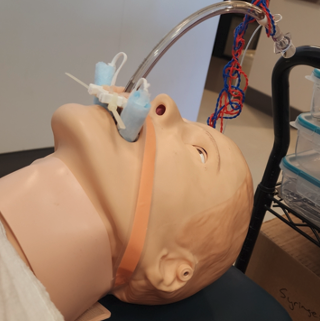Principal Investigator:
Scott Rose, Senior Technician Neuroscience
Background & Unmet Need
- Thyroid surgeries are the most frequently performed endocrine procedures worldwide, with ~150K thyroid surgeries and 40K parathyroid surgeries in the United States per year
- Recurrent laryngeal nerve (RLN) palsy is one of the most common and serious complications from thyroid and parathyroid surgery, which can cause changes in vocal quality such as hoarseness
- Precise positioning of the endotracheal tube (ETT) electrodes with the vocal cords and monitoring with EMG recordings are used to minimize damage in surgeries where the vocal cords are at risk
- There is a lack of devices specifically designed for ETT stabilization after vocal cord alignment with surface electrodes
- Unmet Need: A standardized, easy-to-use system for precisely stabilizing ETTs for thyroid, parathyroid, and other surgeries with increased risk to the laryngeal nerve
Technology Overview
- The Technology: Disposable medical device for secure positioning of endotracheal tube placement for surgeries wherein the vocal cords are at risk
- The device uses teeth positioners, facial tape, and a quick-release clamp to position the ETT with optimal security
- Unlike other devices which use a neck strap to secure the device, which can shift around when patients are moved, this device uses teeth positioners and tape to ensure secure positioning
- The quick-release clamp allows for easy placement and removal of the device
- This device can be used to secure the ETT for thyroid, parathyroid, and for other surgeries wherein vocal cord EMG recordings are taken
- PoC Data: A prototype of this device has been created and positioned on physiologically relevant mannequins
Technology Applications
- ETT placement for thyroid, parathyroid, and other surgeries wherein the vocal cords are at risk
- ETT placement for other procedures in which cranial nerve 10, which innervates the vocal cords, is monitored, such as craniotomy
Technology Advantages
- Device utilizes quick-release clamp for easy placement and removal
- Device does not need neck strap for stabilization, instead utilizing facial tape and teeth positioners
- Device does not require assembly and uses cost-effective materials

Prototype of endotracheal tube placement lock system.
Resources
Intellectual Property
Patents
- Provisional Application Filed
Cornell Reference
- 10071
Contact Information

For additional information please contact
Donna Rounds
Associate Director, Business Development and Licensing
Phone: (646) 780-8775
Email: djr296@cornell.edu

